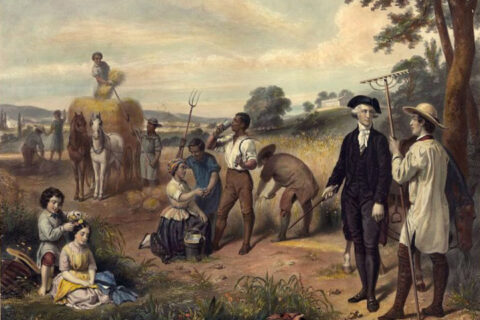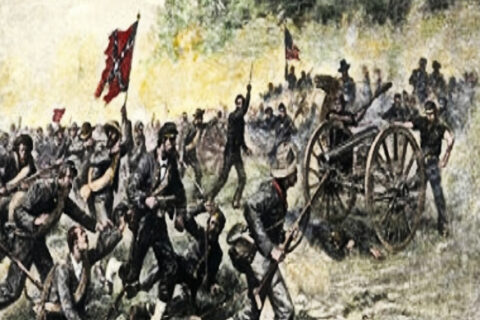When viewing the Tarheel State within the context of its historical place in Dixie, North Carolina portrays an image of, and has often held the reputation of, being the most progressive of the former Confederate constituents. Late to join the Confederacy and divided in popular opinion along ethno-regional lines, North Carolina contributed the most troops to the noble Lost Cause in both per capita and raw numbers. Utterly devastated due to the loss, thousands of Caucasian males never returned home. The population loss crippled the state yet left a dichotomy still in place between its eastern and western regions. Leaving in its wake a broken, weak Planter aristocracy and a baleful, abused Appalachian populace, the War brought with it the infamous Reconstruction Period. This essay will examine the economic, political, and social conditions of North Carolina’s Reconstruction.
Economically, the Tarheel State existed on a bit of a spectrum pre-War. Though wealthy Planters lived within the coastal lowland, a large population of poor Whites lived in the Piedmont and Appalachian hills of the central and western counties. This created a tacit division among the population which flowed into every aspect of society within the state. The War did its work on the state’s financial strength. The areas to receive the heaviest brunt of wartime strain most certainly were the regions through which General Sherman marched his army, picking clean and razing everything in his path.
In 1865, the crop yield returned in abundance, but farms struggled in 1866 and 1867, returning a measly yield. Adding further to the languishing economy, the repudiation of the war debt drove any modicum of relative comfort to the auspices of debilitating poverty. While the spending practices of the Radical regimes tended toward frivolous spending, Holden’s gubernatorial tenure focused less on spending, instead focusing on the Ku Klux crisis which engulfed the state. Little else may be said of the situation.
The political aspects of Reconstruction, though reprehensible, stand uniquely in North Carolina among other former Confederate States, only having much similarity with the state of Tennessee. The heavy population of Appalachian folk , a sizeable Negro population as a result of the state holding one of the largest Southern populaces at the time, and relative lack of comparative proportion of Planters resulted in a situation in which former aristocrats held little sway over the divided population. This resulted in a powerful Republican bloc within the state which developed naturally, as opposed to the “astroturfed” radical regimes of much of the rest of Dixie.
The initial reconstitution of the state carried with it the reestablishment of a Whig majority General Assembly. Under the tutelage of Governor Worth, the state began returning to a sense of slight normalcy, albeit poverty stricken, until the passage of the Reconstruction Acts in 1867. With this came the military dictatorship of General Sickles.
A reprehensible state of affairs, Sickles’ rule was often not maligned, possibly due to his Democratic alignments. He stayed his hand in many scenarios and disliked the Radicals’ overzealous policies. However, he did adhere to the belief of equal rights for Negroes, yet did so without encroaching on the rights of Whites. Many Whites were disappointed to see him given a new assignment. Sickles’ replacement would not treat the North Carolinians so well.
General Canby, Sickles’ replacement, tended towards the fair and unabusive but managed to warrant a negative reputation for himself. His reign became associated with the increasing misery of the state and his overhaul of the civil courts. Additionally, he had difficulty in resolving the issue the state had with wandering Negroes. His appointments were also a bit unpopular, and he did not interact much with the state’s political body. He also never visited the state nor made a public appearance, preferring to work from afar. However, he did effectively organize a registration of the voters and hold a convention in good order. Undeserving of his reputation, his tenure would prove far better for North Carolinians than that of the regime of his successor, the first Republican Governor of the state.
Though the transfer of power never directly sat within his hands during the War and the early years of Reconstruction, William Holden stood as the most important figure in North Carolina politics of the 1860s. Beginning his political career in the 1840s, Holden was an experienced and crafty stateman by the beginning of the War. Opposing it bitterly, he often led a number of peace movements within the state. Outnumbered and bitterly contested by Governor Zebulon Vance, Holden managed to hold his power and influence unwaveringly throughout the War, though he did at times draw the ire of hawkish factions. His truest ascendance to power came in the wake of General Canby’s enforced election and the adoption of a new state constitution. After years of work and planning, leadership of the wartime peace movement, and president of the state’s Union League, Holden was elected Governor of North Carolina in 1868, solidifying the Radical control of North Carolina.
Ambitious and cunning, Holden brought with him a number of goals and ideals. Unfortunately for him and the Radicals, their goals would be derailed by the terror of Ku Klux organizations. Following the murders of Wyatt Outlaw and John W. Stephens, Governor Holden organized the state militia and had it occupy the Piedmont region of the state, initiating the Kirk-Holden War. By 1870, he had effectively driven the Klan out of the state, but the Democrats had won the state legislature and immediately impeached him. Holden became the first American governor to successfully be impeached.
Holden’s successor, Tod Robinson Caldwell, was the first ever Lieutenant Governor of the state. The gist of his tenure amounted to funding for public schools and addressing of the state debt. Little else may be said of his forgettable service, and he died in 1874 while still serving the position.
The next governor, Curtis Brogden, effected more of a footprint in history. Initially a Democrat, Brogden switched to the Republican Party in 1867. By 1874, he was serving as the Lieutenant Governor and assumed the Governorship upon Caldwell’s passing. Unfortunately for him, the Democrats had already regained control of the General Assembly. Skilled as a statesman, Brogden often worked across the aisle with Democrats and spent much of his time working to improve funding for educational purposes, as well as, other public works, such as a penitentiary and lowering of state debt. Brogden would later win election to the U.S. House of Representatives in 1876, where he would continue working to secure support and finances for North Carolina. His gubernatorial term ended in 1877, being markedly better skilled than his predecessors, and he was not re-nominated for Congress in 1878. Zebulon Baird Vance would succeed Brogden as the next governor, finalizing Democratic control over the state.
The most prominent plague upon the social situation of post-War North Carolina, the Negro question, though much less severe than the Deep South, still brought with it significant tumultuous circumstances. Beginning in a volatile position, Negro Union soldiers were stationed across the state. Utilizing their newfound freedom and social superiority, they often harassed local Whites, contributing to a state of affairs already at its boiling point. Thankfully, Negro troops were withdrawn within less than a year after the War’s ceasing, but the problem of what to do with the Freedmen remained. Freedmen often wandered around the countryside, resorted to vagrancy, loitered in cities, committed crimes, and refused to work, having grown used to their former masters’ constant supply of food. While Lowlanders knew more effective ways to interact with Negroes, Appalachians reacted balefully to their presence and social equality, often resorting to violence.
As was typical of a state with large Appalachian stock, Ku Klux organizations thrived in the border regions between the Lowland and the Hill Country, permeating heavily within the Piedmont. Much like Arkansas, the Ku Klux Klan and various white militias engaged in much higher profile warfare in comparison to other former Confederate States. Holden’s gubernatorial service proved exponentially unpopular, and the Klan executed a reign of terror, often in the form of military style raids, throughout the Piedmont. The clashes between the Radicals, Negroes, and Klan in the region resulted in the highly publicized executions of Wyatt Outlaw, Negro Town Commissioner and Constable of Graham, and Republican State Senator John Walter Stephens. These series of actions catalyzed the Kirk-Holden War of 1870.
Utilizing the assistance of Colonel George Washington Kirk and placing him in command of the state militia, Holden declared martial law in Alamance and Graham counties, yet the militia would invade much of the greater Piedmont anyway. The multitude of skirmishes in the region, particularly those two aforementioned counties, gave the war its namesake. The total lockdown of the area, false imprisonment and hearsay trials, and treatment of locals at the hands of a militia led by a hostile scalawag and staffed with a large number of Negroes left Whites awestruck.
The backlash against Holden’s actions in the region, a grave mistake on the Governor’s part considering the vehement distaste for authority among Appalachians, resulted in the Democratic Party seizing the reins of state power the following election in August 1870. Holden was immediately impeached. Breathing a sigh of relief, the population was given a bit of room to relax. Indicative of the divided nature of North Carolinians, a Democratic governor would not immediately follow the party’s ascension. One would eventually be elected in 1877. However, this would not put an end to the Republicans of the state until the 1890s when a series of insurrections carried out by the Red Shirts would solidify Democratic control of the state for generations. North Carolinians still held a long lasting propensity for liberal populism and moderation toward the Negro Question.
The Tarheel State faced a Reconstruction not quite so harsh as the rest of Dixie, yet not so willing to put up with Radicals once their regime pushed too far. The economic, political, and social circumstances left the state just as divided on key issues as when the War and Reconstruction began. Yet, for the time being, North Carolinians would be free from the clutches of leftist Northerners. Unfortunately, the lack of conclusiveness to the Reconstruction Era in North Carolina would lead to the development of a racially conflicted society of disparate groups which would later pride itself as the most progressive Southern State.
“The White people of the South are the greatest minority in this nation. They deserve consideration and understanding instead of the persecution of twisted propaganda.” –Strom Thurmond





